METRO SHANGHAI / CITY PANORAMA
TCM professor at Shanghai University of Traditional Chinese Medicine gaining popularity among foreign students
Translating traditional Chinese medicine
Due to language barriers and cultural differences, popularizing traditional Chinese medicine (TCM), an indispensable part of China's culture, was obstructed in overseas countries in the past. However, the compelling advancement of the Chinese economy and modern Chinese medical science in recent decades has brought TCM back into the global media spotlight. A 59-year-old professor, Li Zhengyu, from Shanghai University of Traditional Chinese Medicine's (SHUTCM) School of Acupuncture-moxibustion and Tuina has dedicated himself for the past three decades to promoting the 2000-year-old tuina (a form of TCM manipulative therapy) worldwide with his English lectures and therapy demonstrations.
Last week, acupuncture anesthesia was successfully applied to three surgeries of coronary angiography at the Yueyang Hospital of Integrated Traditional Chinese and Western Medicine affiliated to SHUTCM, a precedent of the application of acupuncture anesthesia in this kind of surgery.
"TCM's tuina [traditional Chinese massage] can also take the place of opioid analgesics to produce analgesic effects. It is more effective, more comfortable and more convenient than acupuncture, which requires needles. And it is safer than Western chemical medicine, which may have side-effects," Li said.
Based on TCM's medical principles which have a history of two millennia, tuina involves using the hand, palm, knuckles and fingers to apply pressure in meridian and acupressure points to remove blockages along meridian points and stimulate specific areas with qi (body's energy flow) to promote healing.
It is often used in conjunction with acupuncture, fire cupping, herbalism and qigong (Chinese breathing exercise). The therapy can be traced back to China's primitive period, when people used the techniques to treat accidental injuries caused by natural disasters or animal attacks.
As a form of TCM, the knowledge of tuina is extensive and profound. However, with Li's precise and proficient English explanations and demonstrations, even foreign students can easily understand difficult TCM concepts.
Last Thursday, around 20 students from the US attended Li's lecture as a part of their study-abroad trip program. Li introduced several basic skills of the manipulative therapy at the lecture. The students listened to Li with great interest and attentiveness.
Every time Li introduced a new skill, he invited a student to come forward to be his model. Although tuina is a practical discipline which requires much practice, it also requires accurate descriptions of the key points of the skill.
Hands-on learning
Kristine Troutman is a nurse practitioner student from Florida, the US. She joined the study-abroad trip organized by the University of South Alabama to learn about Chinese culture and basic TCM knowledge. She wants to integrate traditional Chinese medicine into her practice.
"This was really my first exposure to TCM, so I'm really interested in finding out the basic principles. I found it very fascinating," Troutman said. "I found it very difficult to do the manipulative therapy. But I can definitely see their worth in practice and how they can help."
Rex Berry from the US state of Kentucky is a medical science student from Duquesne University. He thought it would be a good idea to gain knowledge of different kinds of medicine from around the world. "Seeing different types of practices elsewhere can probably help me in my own practice," Berry said.
Berry had seen tuina therapies in videos but had never learned them in a classroom. "The concepts are easy to understand, though it's hard to put them into practice, which takes years. But Li did a good way of simplifying them for us," Berry said.
Morgan Wimberry from the University of South Alabama also had her first practice of TCM at Li's lecture. She is a healthcare administration major who joined the program to experience different cultures and see how Eastern medicine is practiced compared with Western medicine.
"I really like Professor Li's class. He's good at explaining things. He has some hands-on portions for us where we got to try different things," Wimberry said.
TCM in English
After SHUTCM set up an English language acupuncture-moxibustion and tuina major in 2003 to promote TCM overseas, Li, a doctor from Yueyang Hospital of Integrated Traditional Chinese and Western Medicine affiliated to SHUTCM, was invited to the university to give English lectures.
His foreign students include those from short-term study-abroad TCM programs and also long-term foreign students who are furthering their studies at SHUTCM.
Zhanar, 26, from Kazakhstan has been studying acupuncture and tuina at SHUTCM for the past five years. She prefers TCM to Western medicine because she thinks TCM uses more natural substances such as herbs. She thinks the biggest difficulty foreign students face when studying TCM is the language. But since Li's lecture is in English, she doesn't find it difficult to understand the concepts. "To study medicine, you must clearly understand it," Zhanar said.
Different from many Chinese doctors of Western medication science who studied abroad, Li has given lectures to many foreign students even though he himself never studied abroad.
Influenced by his family members - his mother was a medical science professor at the former Shanghai Medical College and his wife is a current English professor from Shanghai Medical College of Fudan University - the TCM doctor obtained his bachelor's, master's and doctorial degrees at SHUTCM and is excellent at both medical science and English language skills.
Li's English talent was first revealed as early as 1988, when an American patient who could not speak Chinese was seeking treatment at Yueyang Hospital. No other doctor could speak English at that time except Li. Finally, Li interpreted for the patient and the president of the hospital.
Since then, more and more foreign patients and guests come to the hospital for treatment or to study. Over the years, Li has demonstrated, taught and promoted tuina therapy in many overseas countries as a TCM doctor or as a teacher.
Li once treated a White House doctor with his palm back rolling manipulation when he visited the US. He also treated a high-level executive of an American medication group with his "one finger" manipulation.
Gaining popularity overseas
As deputy director of manipulative therapy specialty commission of the World Federation of Chinese Medicine Societies, a non-governmental international academic organization which promotes TCM across the world, Li demonstrates and promotes tuina therapy overseas every two or three years during the World Congress of Chinese Medicine held by the organization.
The congress is held in different countries across the world and is attended by people from all over the world who are interested or specialized in TCM.
Last year, Li promoted tuina and acupuncture in Dubai, where China's State Administration of Traditional Chinese Medicine launched its Dubai center of TCM. His treatment was praised by some Dubai officials and their family members. Later this year, he will fly to either Canada or Germany to showcase the effectiveness of the TCM therapy.
Veerachai Soottitantawat, 47, is a Chinese-Thai national who is doing his PhD at SHUTCM. He finished his undergraduate program of TCM in Thailand, where he first met Li, who was sent to his university to teach TCM. Inspired by Li, Soottitantawat continued his postgraduate studies at SHUTCM for three years then went back to Thailand to pursue his career.
Two years ago, Soottitantawat returned to Shanghai to further his studies at SHUTCM. "Thailand also has its own massage therapy, but its techniques are different from TCM's tuina," Soottitantawat said.
Sarah, a German student of Li, who took part in an exchange program in SHUTCM, did a part-time job at her German college mentor's clinic. Once, a patient was not willing to receive surgery for a backache and pains in the lower limb. Since she studied TCM in China, her mentor asked if she could do something for the patient with TCM therapies.
Sarah used tuina to relieve the patient's pains. After graduation, her mentor asked her to work at the clinic. "A few years ago, she wrote to me and wanted to learn tuina for the treatment of cervical spondylosis," Li said. "The cost of surgeries is very expensive in overseas countries. If the problem is not serious, tuina can solve the problem without costing much. This is also why tuina is popular."
Standardized terminology
"Different from Western medicine, which is a chemical, tuina is a physical and natural therapy that is becoming very popular in Western countries," said Li, whose effective treatments and demonstrations overseas helped enhance TCM's popularization in overseas countries.
Troutman thinks more Americans are gradually accepting TCM. "So I'm hoping to bring it to the forefront and hope to apply what I learned into my practice," Troutman said.
"As China grows stronger, more Chinese culture is being exported. As an indispensable part of Chinese traditional culture, TCM can be used as a starting point to spread Chinese culture," Li said.
Li thinks the promotion of TCM through tuina is easier than acupuncture because tuina is more easily accepted for its convenience and comfort. "Many overseas countries and regions demand licenses to practice acupuncture with needles," Li said. "And the comfortable feeling generated by beta-endorphins when receiving tuina treatment also makes the therapy increasingly popular."
"Tuina used to be called anmo (Chinese for massage) in ancient China. But that type of massage is different from what is today conducted at roadside massage parlors. Ancient anmo used to be a part of Chinese medical science.
"Tuina is a manipulative therapy for disease treatment and prevention, or health care under the guidance of TCM principles. So the standard name of the therapy should be tuina. Although roadside massages can also offer relaxation, it has no real medical effect."
The popularization of TCM cannot be accomplished without a precise translation. According to Li, there is no standardization commission for the English translation of TCM in China. But over the years, English translations of some TCM terminologies have become fixed, such as yin, yang, qi, qigong and tuina.
Li is involved in a project by the World Health Organization to develop a standardized terminology for TCM practices. Li is responsible for the Chinese and English translations of tuina terms.
"Public English translators or translators who know only about Western medicine cannot translate TCM into English precisely. Since TCM is a part of Chinese traditional culture, TCM practitioners should first bring forward TCM concepts and translate them into English.
"During the translation process, we can discuss this with foreigners. With the internationalization of China, there are more opportunities for TCM practitioners to communicate with foreigners," Li added.
Li often discusses TCM translation with his wife, who graduated from Shanghai International Studies University and is now teaching English at Fudan.
"It is impossible to find a completely equivalent English translation for every TCM concept. Sometimes we have to differentiate some concepts and persist to the Chinese elements. For example, I insist on using the pinyin word for tuina instead of the word 'massage' when translating the traditional Chinese massage."
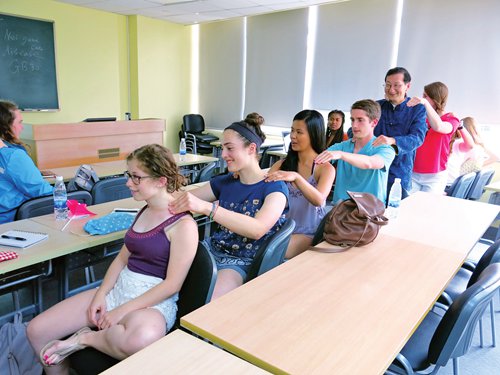
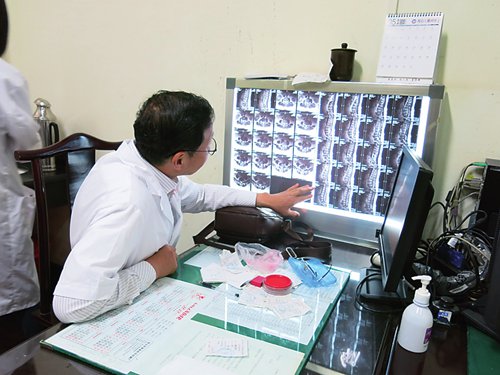
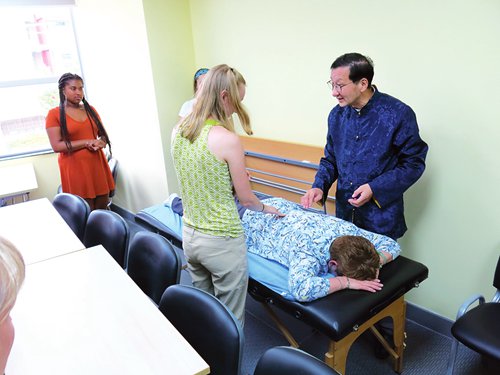
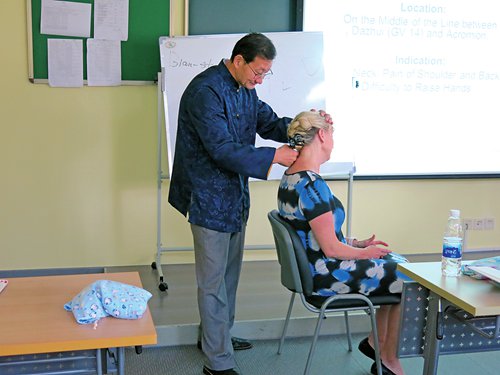
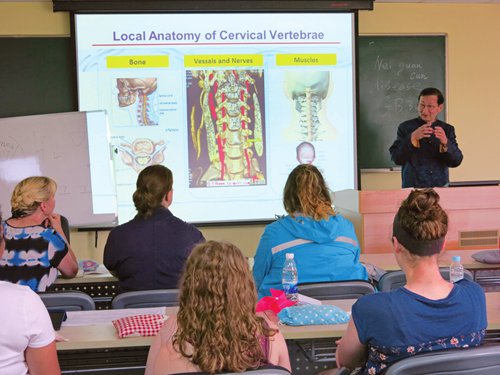
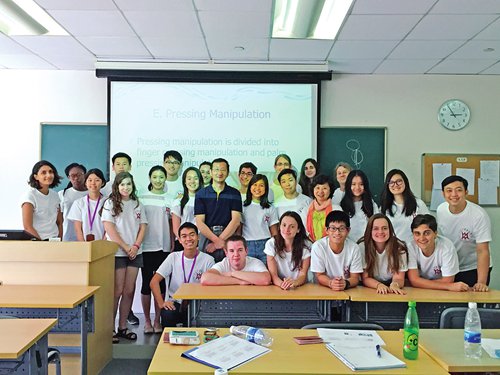
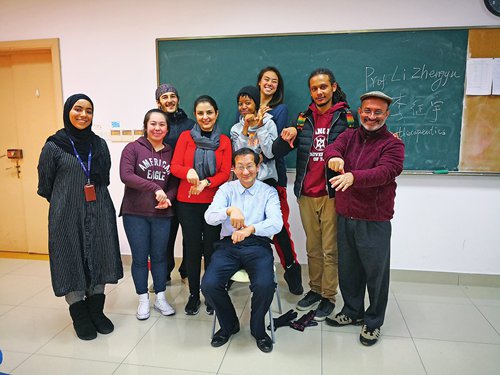
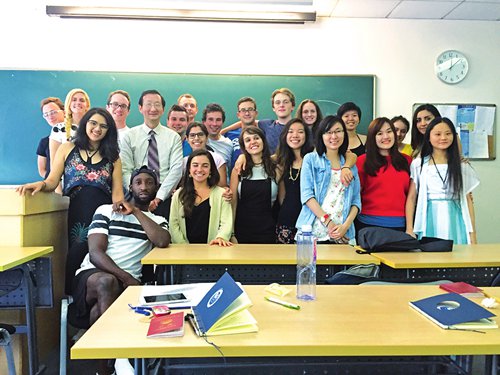
Last week, acupuncture anesthesia was successfully applied to three surgeries of coronary angiography at the Yueyang Hospital of Integrated Traditional Chinese and Western Medicine affiliated to SHUTCM, a precedent of the application of acupuncture anesthesia in this kind of surgery.
"TCM's tuina [traditional Chinese massage] can also take the place of opioid analgesics to produce analgesic effects. It is more effective, more comfortable and more convenient than acupuncture, which requires needles. And it is safer than Western chemical medicine, which may have side-effects," Li said.
Based on TCM's medical principles which have a history of two millennia, tuina involves using the hand, palm, knuckles and fingers to apply pressure in meridian and acupressure points to remove blockages along meridian points and stimulate specific areas with qi (body's energy flow) to promote healing.
It is often used in conjunction with acupuncture, fire cupping, herbalism and qigong (Chinese breathing exercise). The therapy can be traced back to China's primitive period, when people used the techniques to treat accidental injuries caused by natural disasters or animal attacks.
As a form of TCM, the knowledge of tuina is extensive and profound. However, with Li's precise and proficient English explanations and demonstrations, even foreign students can easily understand difficult TCM concepts.
Last Thursday, around 20 students from the US attended Li's lecture as a part of their study-abroad trip program. Li introduced several basic skills of the manipulative therapy at the lecture. The students listened to Li with great interest and attentiveness.
Every time Li introduced a new skill, he invited a student to come forward to be his model. Although tuina is a practical discipline which requires much practice, it also requires accurate descriptions of the key points of the skill.
Hands-on learning
Kristine Troutman is a nurse practitioner student from Florida, the US. She joined the study-abroad trip organized by the University of South Alabama to learn about Chinese culture and basic TCM knowledge. She wants to integrate traditional Chinese medicine into her practice.
"This was really my first exposure to TCM, so I'm really interested in finding out the basic principles. I found it very fascinating," Troutman said. "I found it very difficult to do the manipulative therapy. But I can definitely see their worth in practice and how they can help."
Rex Berry from the US state of Kentucky is a medical science student from Duquesne University. He thought it would be a good idea to gain knowledge of different kinds of medicine from around the world. "Seeing different types of practices elsewhere can probably help me in my own practice," Berry said.
Berry had seen tuina therapies in videos but had never learned them in a classroom. "The concepts are easy to understand, though it's hard to put them into practice, which takes years. But Li did a good way of simplifying them for us," Berry said.
Morgan Wimberry from the University of South Alabama also had her first practice of TCM at Li's lecture. She is a healthcare administration major who joined the program to experience different cultures and see how Eastern medicine is practiced compared with Western medicine.
"I really like Professor Li's class. He's good at explaining things. He has some hands-on portions for us where we got to try different things," Wimberry said.
TCM in English
After SHUTCM set up an English language acupuncture-moxibustion and tuina major in 2003 to promote TCM overseas, Li, a doctor from Yueyang Hospital of Integrated Traditional Chinese and Western Medicine affiliated to SHUTCM, was invited to the university to give English lectures.
His foreign students include those from short-term study-abroad TCM programs and also long-term foreign students who are furthering their studies at SHUTCM.
Zhanar, 26, from Kazakhstan has been studying acupuncture and tuina at SHUTCM for the past five years. She prefers TCM to Western medicine because she thinks TCM uses more natural substances such as herbs. She thinks the biggest difficulty foreign students face when studying TCM is the language. But since Li's lecture is in English, she doesn't find it difficult to understand the concepts. "To study medicine, you must clearly understand it," Zhanar said.
Different from many Chinese doctors of Western medication science who studied abroad, Li has given lectures to many foreign students even though he himself never studied abroad.
Influenced by his family members - his mother was a medical science professor at the former Shanghai Medical College and his wife is a current English professor from Shanghai Medical College of Fudan University - the TCM doctor obtained his bachelor's, master's and doctorial degrees at SHUTCM and is excellent at both medical science and English language skills.
Li's English talent was first revealed as early as 1988, when an American patient who could not speak Chinese was seeking treatment at Yueyang Hospital. No other doctor could speak English at that time except Li. Finally, Li interpreted for the patient and the president of the hospital.
Since then, more and more foreign patients and guests come to the hospital for treatment or to study. Over the years, Li has demonstrated, taught and promoted tuina therapy in many overseas countries as a TCM doctor or as a teacher.
Li once treated a White House doctor with his palm back rolling manipulation when he visited the US. He also treated a high-level executive of an American medication group with his "one finger" manipulation.
Gaining popularity overseas
As deputy director of manipulative therapy specialty commission of the World Federation of Chinese Medicine Societies, a non-governmental international academic organization which promotes TCM across the world, Li demonstrates and promotes tuina therapy overseas every two or three years during the World Congress of Chinese Medicine held by the organization.
The congress is held in different countries across the world and is attended by people from all over the world who are interested or specialized in TCM.
Last year, Li promoted tuina and acupuncture in Dubai, where China's State Administration of Traditional Chinese Medicine launched its Dubai center of TCM. His treatment was praised by some Dubai officials and their family members. Later this year, he will fly to either Canada or Germany to showcase the effectiveness of the TCM therapy.
Veerachai Soottitantawat, 47, is a Chinese-Thai national who is doing his PhD at SHUTCM. He finished his undergraduate program of TCM in Thailand, where he first met Li, who was sent to his university to teach TCM. Inspired by Li, Soottitantawat continued his postgraduate studies at SHUTCM for three years then went back to Thailand to pursue his career.
Two years ago, Soottitantawat returned to Shanghai to further his studies at SHUTCM. "Thailand also has its own massage therapy, but its techniques are different from TCM's tuina," Soottitantawat said.
Sarah, a German student of Li, who took part in an exchange program in SHUTCM, did a part-time job at her German college mentor's clinic. Once, a patient was not willing to receive surgery for a backache and pains in the lower limb. Since she studied TCM in China, her mentor asked if she could do something for the patient with TCM therapies.
Sarah used tuina to relieve the patient's pains. After graduation, her mentor asked her to work at the clinic. "A few years ago, she wrote to me and wanted to learn tuina for the treatment of cervical spondylosis," Li said. "The cost of surgeries is very expensive in overseas countries. If the problem is not serious, tuina can solve the problem without costing much. This is also why tuina is popular."
Standardized terminology
"Different from Western medicine, which is a chemical, tuina is a physical and natural therapy that is becoming very popular in Western countries," said Li, whose effective treatments and demonstrations overseas helped enhance TCM's popularization in overseas countries.
Troutman thinks more Americans are gradually accepting TCM. "So I'm hoping to bring it to the forefront and hope to apply what I learned into my practice," Troutman said.
"As China grows stronger, more Chinese culture is being exported. As an indispensable part of Chinese traditional culture, TCM can be used as a starting point to spread Chinese culture," Li said.
Li thinks the promotion of TCM through tuina is easier than acupuncture because tuina is more easily accepted for its convenience and comfort. "Many overseas countries and regions demand licenses to practice acupuncture with needles," Li said. "And the comfortable feeling generated by beta-endorphins when receiving tuina treatment also makes the therapy increasingly popular."
"Tuina used to be called anmo (Chinese for massage) in ancient China. But that type of massage is different from what is today conducted at roadside massage parlors. Ancient anmo used to be a part of Chinese medical science.
"Tuina is a manipulative therapy for disease treatment and prevention, or health care under the guidance of TCM principles. So the standard name of the therapy should be tuina. Although roadside massages can also offer relaxation, it has no real medical effect."
The popularization of TCM cannot be accomplished without a precise translation. According to Li, there is no standardization commission for the English translation of TCM in China. But over the years, English translations of some TCM terminologies have become fixed, such as yin, yang, qi, qigong and tuina.
Li is involved in a project by the World Health Organization to develop a standardized terminology for TCM practices. Li is responsible for the Chinese and English translations of tuina terms.
"Public English translators or translators who know only about Western medicine cannot translate TCM into English precisely. Since TCM is a part of Chinese traditional culture, TCM practitioners should first bring forward TCM concepts and translate them into English.
"During the translation process, we can discuss this with foreigners. With the internationalization of China, there are more opportunities for TCM practitioners to communicate with foreigners," Li added.
Li often discusses TCM translation with his wife, who graduated from Shanghai International Studies University and is now teaching English at Fudan.
"It is impossible to find a completely equivalent English translation for every TCM concept. Sometimes we have to differentiate some concepts and persist to the Chinese elements. For example, I insist on using the pinyin word for tuina instead of the word 'massage' when translating the traditional Chinese massage."

Foreign students practice traditional Chinese massage. Photos:Du Qiongfang/GT

Li Zhengyu studies a patient's documents. Photos:Du Qiongfang/GT

In-class TCM demonstration Photos:Du Qiongfang/GT

In-class TCM demonstration Photos:Du Qiongfang/GT

Li Zhengyu delivers a TCM class to foreigners. Photos:Du Qiongfang/GT

Li Zhengyu with his foreign students.Photos:Courtesy of Li Zhengyu

Li Zhengyu with his foreign students.Photos:Courtesy of Li Zhengyu

Li Zhengyu with his foreign students.Photos:Courtesy of Li Zhengyu
